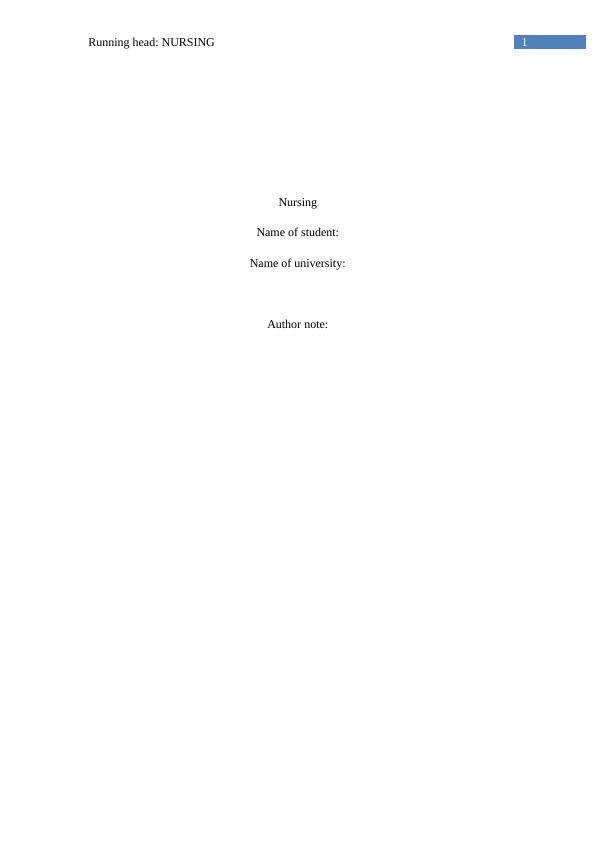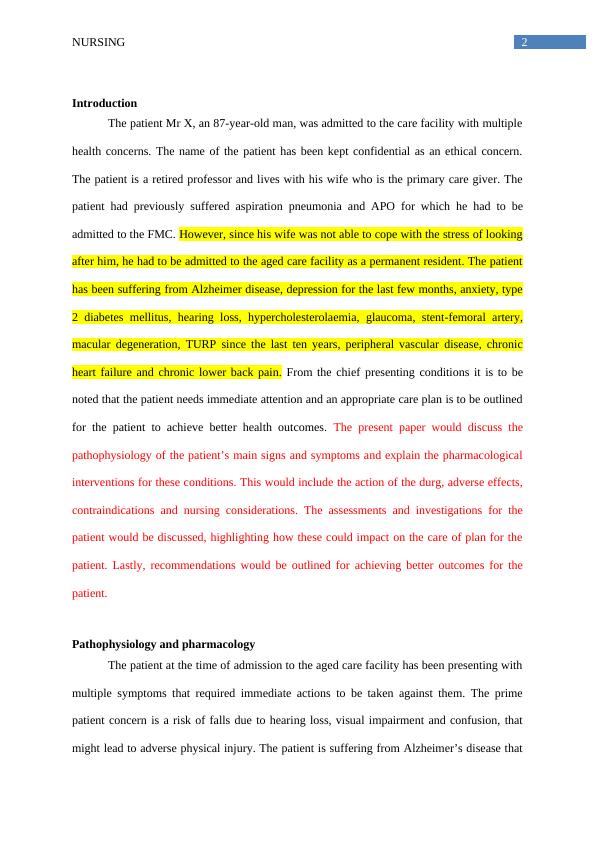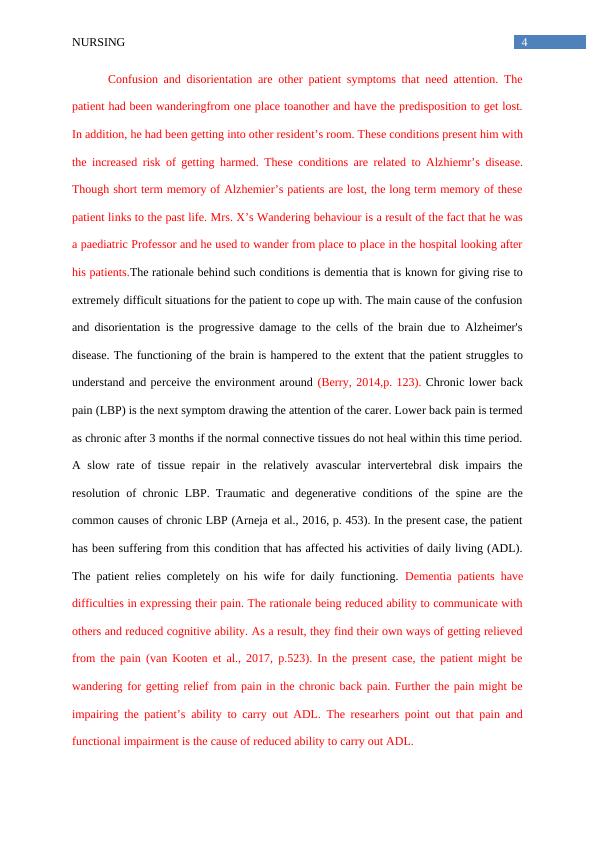Pharmacology: Connection to Nursing
Added on 2020-05-11
13 Pages3871 Words90 Views
1Running head: NURSINGNursing Name of student:Name of university:Author note:

2NURSINGIntroductionThe patient Mr X, an 87-year-old man, was admitted to the care facility with multiplehealth concerns. The name of the patient has been kept confidential as an ethical concern.The patient is a retired professor and lives with his wife who is the primary care giver. Thepatient had previously suffered aspiration pneumonia and APO for which he had to beadmitted to the FMC. However, since his wife was not able to cope with the stress of lookingafter him, he had to be admitted to the aged care facility as a permanent resident. The patienthas been suffering from Alzheimer disease, depression for the last few months, anxiety, type2 diabetes mellitus, hearing loss, hypercholesterolaemia, glaucoma, stent-femoral artery,macular degeneration, TURP since the last ten years, peripheral vascular disease, chronicheart failure and chronic lower back pain. From the chief presenting conditions it is to benoted that the patient needs immediate attention and an appropriate care plan is to be outlinedfor the patient to achieve better health outcomes. The present paper would discuss thepathophysiology of the patient’s main signs and symptoms and explain the pharmacologicalinterventions for these conditions. This would include the action of the durg, adverse effects,contraindications and nursing considerations. The assessments and investigations for thepatient would be discussed, highlighting how these could impact on the care of plan for thepatient. Lastly, recommendations would be outlined for achieving better outcomes for thepatient.Pathophysiology and pharmacologyThe patient at the time of admission to the aged care facility has been presenting withmultiple symptoms that required immediate actions to be taken against them. The primepatient concern is a risk of falls due to hearing loss, visual impairment and confusion, thatmight lead to adverse physical injury. The patient is suffering from Alzheimer’s disease that

3NURSINGhas been detected recently. According to Wimo et al., (2013, p. 15) hearing and sight loss arethe two most striking complication suffered by a patient of Alzheimer's disease, a form ofdementia. A number of cross-sectional studies have pointed out that there lies an associationbetween sensory impairments and cognitive decline in case of dementia. Such sensoryimpairments include hearing and visual impairment. Dementia, including Alzheimer'sdisease, is one of the major disorder suffered by individuals aged 70 and above wherein anumber of problems are suffered by the patient. The pathology of this disease is marked theabnormal aggregates of beta-amyloid deposited in the brain in the form of senile plaquesalong with neurofibrillary tangles of abnormally phosphoryated tau. Dementia leads to anumber of visual problems such as colour vision loss, visual acuity loss, changes in pupillaryresponse to mydriatics, defects eye movements, disturbances of complex optical functionssuch as reading and detecting objects. The decline in hearing ability is a neurologicalimpairment due to the changes in the functioning of the brain. Risk factors for falls in olderpatients include both intrinsic (person-centered) and extrinsic (environmental) factors. Someof the most important intrinsic factors can involve balance impairment, hearing, cognition,muscle strength, vision, gait, and symptoms realted to depressions. Hearing dysfunctions isfound to be the third most common chronic ailment in the older adults aged 65 years andabove. Hearing impairment can decrease the quality of life and is independently related withdifficulties in walking, functional decline, social isolation and impaired cognition. A numberof research studies have highlighted hearing dysfunction in relation to fall related risks.Patients suffering from hearing impairment need increased attention for the detection andprocessing of auditory cues, leaving alteredattentional resources for balance control(Steinberg etal., 2015, p. 446). Vision impairment is directly linked with risk of falls. Thedirect and simple mechanism is that people having vision impairments do not identifyenvironmental hazards beyond their line of sight (Beltran et al., 2015, p. E5844-45).

4NURSINGConfusion and disorientation are other patient symptoms that need attention. Thepatient had been wanderingfrom one place toanother and have the predisposition to get lost.In addition, he had been getting into other resident’s room. These conditions present him withthe increased risk of getting harmed. These conditions are related to Alzhiemr’s disease.Though short term memory of Alzhemier’s patients are lost, the long term memory of thesepatient links to the past life. Mrs. X’s Wandering behaviour is a result of the fact that he wasa paediatric Professor and he used to wander from place to place in the hospital looking afterhis patients.The rationale behind such conditions is dementia that is known for giving rise toextremely difficult situations for the patient to cope up with. The main cause of the confusionand disorientation is the progressive damage to the cells of the brain due to Alzheimer'sdisease. The functioning of the brain is hampered to the extent that the patient struggles tounderstand and perceive the environment around (Berry, 2014,p. 123). Chronic lower backpain (LBP) is the next symptom drawing the attention of the carer. Lower back pain is termedas chronic after 3 months if the normal connective tissues do not heal within this time period.A slow rate of tissue repair in the relatively avascular intervertebral disk impairs theresolution of chronic LBP. Traumatic and degenerative conditions of the spine are thecommon causes of chronic LBP (Arneja et al., 2016, p. 453). In the present case, the patienthas been suffering from this condition that has affected his activities of daily living (ADL).The patient relies completely on his wife for daily functioning. Dementia patients havedifficulties in expressing their pain. The rationale being reduced ability to communicate withothers and reduced cognitive ability. As a result, they find their own ways of getting relievedfrom the pain (van Kooten et al., 2017, p.523). In the present case, the patient might bewandering for getting relief from pain in the chronic back pain. Further the pain might beimpairing the patient’s ability to carry out ADL. The researhers point out that pain andfunctional impairment is the cause of reduced ability to carry out ADL.

End of preview
Want to access all the pages? Upload your documents or become a member.
Related Documents
Alzheimer Disease Project PDFlg...
|14
|3441
|143
Use of Music Therapy in Dementia: A Case Studylg...
|2
|993
|159
Case Study on Global Burden of Diseaselg...
|13
|3353
|14
Dementia Care: Symptoms, Pathophysiology, and MMSE Assessment Toollg...
|19
|5501
|339
Use of Music Therapy in Dementialg...
|4
|1031
|77
HNB3209 - Report on Nursing and The Communitylg...
|12
|3009
|98
